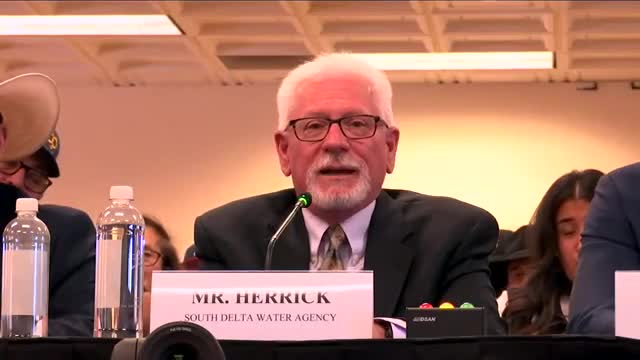Water Crisis Deepens as Regulations Fuel Subsidence Issues
September 06, 2024 | Natural Resources: House Committee, Standing Committees - House & Senate, Congressional Hearings Compilation
This article was created by AI summarizing key points discussed. AI makes mistakes, so for full details and context, please refer to the video of the full meeting. Please report any errors so we can fix them. Report an error »

In a recent government meeting focused on water management and environmental concerns, officials discussed the pressing issues of species extinction, water quality, and infrastructure challenges in California's agricultural regions. The dialogue highlighted the detrimental effects of untreated nutrient runoff into the Delta, which contributes to harmful algal blooms that threaten aquatic life. Participants emphasized the need for stricter enforcement of the Clean Water Act to mitigate these impacts.
Concerns were raised about the aging water infrastructure, particularly the Franklin Canal, which is experiencing subsidence that jeopardizes water transport capabilities. Stakeholders pointed out that proactive measures to address groundwater overdrafting are hindered by regulatory barriers, complicating efforts to provide farmers with surface water alternatives.
The meeting also scrutinized the California State Water Resources Control Board's role in exacerbating subsidence issues through its water quality control plans, which some officials argue prioritize environmental water use over agricultural needs. This has led to frustrations regarding the Bureau of Reclamation's lack of engagement with local water districts and agricultural communities, with claims that the agency is unresponsive to stakeholder input.
Participants called for greater transparency and collaboration in regulatory processes, suggesting that new regulations should not be imposed without congressional approval. The discussion underscored the need for a comprehensive understanding of the economic impacts resulting from water shortages, with a request for data on job losses and financial damages linked to reduced water allocations.
As the meeting concluded, officials expressed a commitment to addressing these challenges through proposed legislative measures, including the upcoming ESA Amendments Act, aimed at reforming the Endangered Species Act to better balance environmental and agricultural interests. The meeting served as a critical platform for stakeholders to voice their concerns and seek collaborative solutions to California's complex water management issues.
Concerns were raised about the aging water infrastructure, particularly the Franklin Canal, which is experiencing subsidence that jeopardizes water transport capabilities. Stakeholders pointed out that proactive measures to address groundwater overdrafting are hindered by regulatory barriers, complicating efforts to provide farmers with surface water alternatives.
The meeting also scrutinized the California State Water Resources Control Board's role in exacerbating subsidence issues through its water quality control plans, which some officials argue prioritize environmental water use over agricultural needs. This has led to frustrations regarding the Bureau of Reclamation's lack of engagement with local water districts and agricultural communities, with claims that the agency is unresponsive to stakeholder input.
Participants called for greater transparency and collaboration in regulatory processes, suggesting that new regulations should not be imposed without congressional approval. The discussion underscored the need for a comprehensive understanding of the economic impacts resulting from water shortages, with a request for data on job losses and financial damages linked to reduced water allocations.
As the meeting concluded, officials expressed a commitment to addressing these challenges through proposed legislative measures, including the upcoming ESA Amendments Act, aimed at reforming the Endangered Species Act to better balance environmental and agricultural interests. The meeting served as a critical platform for stakeholders to voice their concerns and seek collaborative solutions to California's complex water management issues.
View full meeting
This article is based on a recent meeting—watch the full video and explore the complete transcript for deeper insights into the discussion.
View full meeting